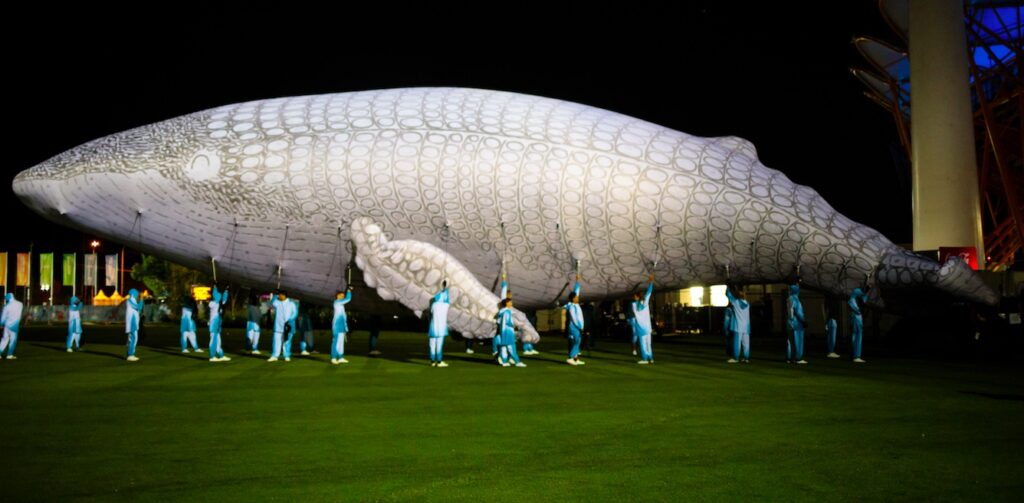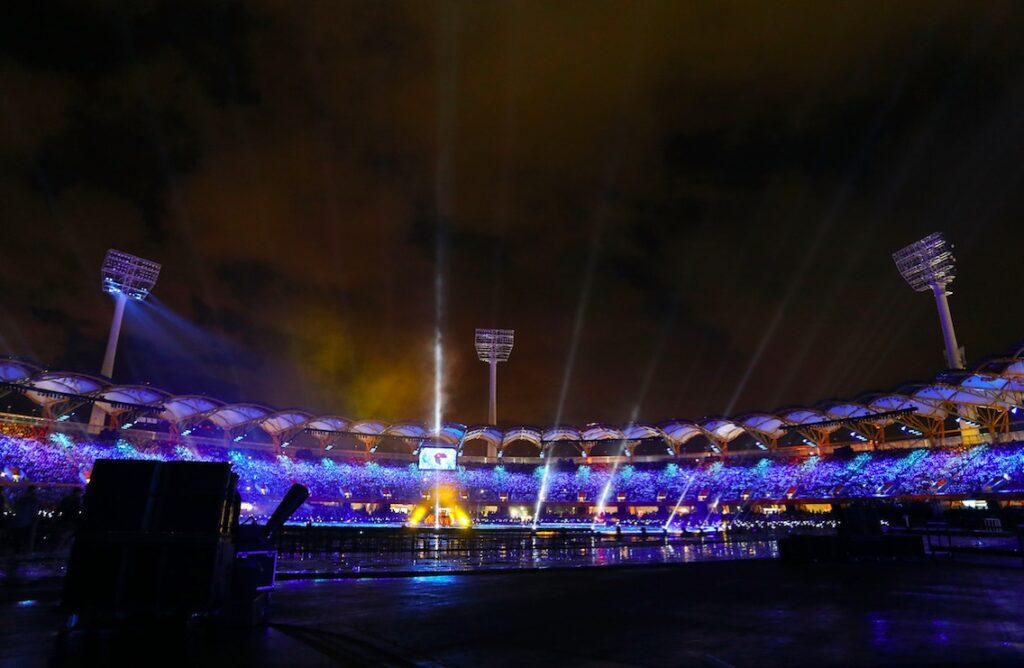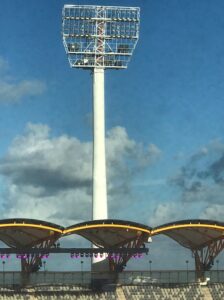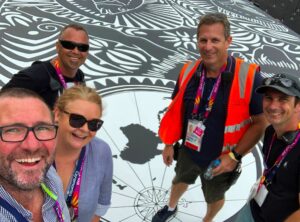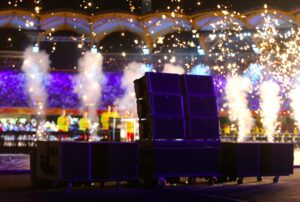News
8 May 2018
Interview with Scott Buchanan Technical Director for the Commonwealth Games Opening and Closing Ceremonies

Subscribe to CX E-News
EVENTS
Interview with Scott Buchanan Technical Director for the Commonwealth Games Opening and Closing Ceremonies
In order to deliver the creative elements of the Opening and Closing Ceremonies the technical team working tirelessly behind the scenes did what technical teams around the country always do – delivered competently and without fanfare. Scott Buchanan, Technical Director for the Commonwealth Games Opening Ceremony, is a local residing on the Gold Coast who has come far in the event world having worked on the 2006 Asian Games in Doha, 2010 Delhi Commonwealth Games & Glasgow Handover, the London 2012 Ceremonies, 2014 Sochi Winter Olympic Games and the Baku 2015 European Games. Scott, who refers to himself as just a plumber from Dubbo, found time to chat with CX between the Opening and Closing Ceremonies.
What is your scope of work?
Basically, we take the creative intent of the creative team and turn that into reality. Anything from scenic and staging elements for the ceremonies through to the technology used for lighting, audio and vision. We also arrange all the plant, forklift and EWP equipment as well as the labour force. It’s an extensive scope of works but having a brilliant team behind the technical departments makes it somewhat easier.
Are there any major differences between the 2018 Commonwealth Games and other large scale events you’ve worked on?
Not really. This is the seventh Games I’ve worked on and they all have the same processes. There are some differences to normal shows, particularly accreditation requirements that need background checking and the process of having equipment screened and checked going into sites. Apart from that, there’s no real difference to doing a corporate show – everything is just up-scaled. Of course, that comes with its problems as well such as running power cables over great lengths, as we are, which means power loss and you have to account for that.
The biggest complications you have with the Games is the security measures, which are there for a very good reason but they are the things newcomers to the Games get quite frustrated over. Compared to other Games, it’s no more or less difficult here on the Gold Coast.
Is there anything specific to the Gold Coast that creates technical issues? We’ve heard the RF environment is quite difficult.
Yes, spectrum is very tight particularly with all the digital television networks coming from Brisbane and NSW. Getting the frequencies you need to run a show of this size is difficult but we engaged early on with the Australian Communications and Media Authority and they’ve been fantastic through the whole process ensuring we get our requirements fulfilled, making sure the spectrum is clean and there are no unlicensed parties. They are based onsite and if we identify anything, they get onto it straight away.
How many technical staff are you overseeing?
Jack Morton directly employ around 35 key technical staff, the number varies during the event, but then each of the contractors can have ten to forty staff and then the labour force alone runs into 160 people.
We engaged early on to provide an opportunity for students to experience such a unique opportunity of large scale events. 15 Students during the course of the project experienced working on the event during the design development, pre-production and the delivery stages.
I want to specially mention the hard-working team of volunteers that worked with the technical department. The event would not happen without this dedicated team that volunteer their time.
Were there any key pieces of technology that made a difference?
We had the BlackTrax system which I believe has never been used on the scale that we used it and it reduced the number of follow spot requirements for us. In fact we only had four follow spots as the BlackTrax system allowed us to track the beacons on the field of play. It worked really well, obviously there was longer commissioning for the size of the venue but we had allowed for this in our schedule.
We used Riedel’s new Bolero wireless intercom solution and we were very impressed with the system. In my opinion, it’s a game changer and the set up time was half of any other system I have seen before. The versatility of it is incredible, the programming and to be able to switch from panel to individual pack is something we utilise a lot in the show. To be able to talk direct to individual people down on the field of play, we bought sixty-five Bolero packs into the show and we ran out because they became a vital piece of kit for us.
We have around 600 lighting fixtures although we have joked with John Rayment that as the LED field has around 7000 LED pixels, it’s got to be the largest amount of fixtures he’s ever had! LEDs are making a big impact on ceremonies especially when combined with wireless technology. The LED star field was wireless technology, IR triggered and we had some other wireless DMX products. In 2012 in London we were looking at kinetic batteries and hopefully kinetics with power sources will become more popular. In 2012 the technology wasn’t quite there and it still isn’t, but technology is developing very quickly in the way we stage things.
Which technologies do you anticipate making an impact in future live events?
In the future audio, video, lighting and comms all need to get on the one network. Over the years there has been some understandable hesitancy from each of the disciplines, maintaining their own network and ensuring they have a system in place that is robust. But we are going down the path of fibre networks that can have all of the disciplines onboard and I think that’s the next step as far as infrastructure goes; a fully redundant single network for all.
What technical aspect was the hardest to get right?
I don’t think there was a single source of difficulties, it was getting it all to work in line with each other at the right times.
A lot of these shows are run from timecode so once the system is up and running, and you’re triggering via timecode, it’s over to the computers to a certain degree. Making sure each of the technologies wasn’t interfering with the other technologies was a challenge, not necessarily RF as it could be as simple as latency on some of the systems.
The biggest challenge with this show was definitely the weather. Wind affected our load in process and delayed some of the installation. We planned for such an event but we had an abnormal amount of high wind days however we managed to rearrange things to make the time back up.
Five minutes before broadcast started on the night we had very heavy rainfall. It was the icing on the cake as we’d had so much rain during the set up. Water got into some of the gear and whilst that’s fixable after the show, there’s not much you can do during it. We lost a number of lights on the field of play which was disappointing but to the average viewer they wouldn’t have noticed it.
We had to keep an eye on the wind too as it was above parameters for Migaloo, the inflatable whale. Fortunately the wind dropped and he was good to go, but it was a tense time.
There was a lot of pushback against the fact that “overseas” companies won some of the technical and production contracts. What’s your take on that?
Ceremonies are an international market and we have a fair and just tendering process that gave preferential scoring to Australian suppliers. However even with that preferential treatment, they still may not meet the technical requirements and commercial parameters to do the project. Having said that, the majority of suppliers were Australian. Turning it around, there are a number of large ceremonies done around the world with Australian suppliers.
What are you doing next?
I’m taking some time off to get to know my wife and children again and also mow the lawns!
Lighting System
The main lighting system was comprised of over 350 Robe high output moving heads with 154 Robe profiles and 202 Robe washes, supplemented by 10 Ayrton S-25 Wildsun MK2s. For the audience lighting there were 104 GLP impression X4 Bar 20s, and 73 Claypaky B-Eye K20s. The field of play and scenic lighting utilised a combination of 35 x Claypaky Sharpy’s and 50 x Claypaky Sharpy Washes.
In a bid to reduce the number of seat kills around the stadium the lighting designer John Rayment chose to utilise an infrared tracking system (Blacktrax) which would be supplemented by 4 x Robert Juliat Lancelot follow spots. The BlackTrax system utilises 20 x 4.1 Megapixel motion capture infrared cameras located around the stadium bowl and roof. Over 40 cast members and scenic items were tracked using 24 beacons and around 50 stringers.
For atmosphere effects there were 12 x Haze Base Pros and 10 Look Solutions Vipers created the ring of smoke effect around the sand stage surround with the help of a compressed Air Venturi system. Driving all of this was an MA Lighting grandMA2 with a fully redundant fibre ring to transport the signal around the stadium.

Starfield on trolleys, 7000 individual LED lights on bases were used in both the Opening and Closing Ceremonies (Photo: Ken Nakanishi for Jack Morton Worldwide)
LED Starfield
To create the starfield that surrounded the stage we worked with PIXMOB to customise their wristband product to remote the LED’s from the IR receiver and control module. These were then placed on carbon fibre rods to elevate them. The 7000 stars took two weeks to construct with the assistance of a team of volunteers.
Audio System
Norwest Productions, fronted by their Manager of Special Events, Andrew Marsh, provided the audio requirements for the ceremonies. The ground-stacked loudspeaker system consisted of 25 arrays of L-Acoustics K2, K1SB, & KS28 Subs. Amplification for the ground-stacked arrays consisted of 7 nodes of LA-RAKs and LA-RAK IIs, with LA12X amplifiers. Further flown arrays of K2 and K1Sb were also powered by LA RAK II. The temporary Northern grandstand was well covered by a system of multiple pole-mounted ARCS WiFo in addition to the ground arrays.
FOH Control was handled with 2 DiGiCo SD5 digital mixing consoles connected to an Optocore digital network. Ian Shapcott was the main FOH Engineer and loudspeaker System Designer.Monitor control was with 2 DiGiCo SD9i digital mixing consoles running Core 2 software enabling 96 input channels and 48 busses. The in-ear monitoring for HLT and core cast groups were done utilising the Sennheiser SR2050 Dual Transmitters with 50 Sennheiser EK2000 Receiver Belt packs for Level 1 and 200 Sennheiser EK300 Receiver Belt packs for the Level 2 requirements. Additionally, to this, over 12,000 FM receivers of level 3 IEMs were used for all the mass cast and athletes.
As part of the overall package Norwest Productions also provided a broadcast audio truck to deliver a dedicated mix for broadcast.
Jim Monk operated the Studer Vista 5 mixing console for both ceremonies, and fed his mix out to the host broadcasters.Norwest supplied an integrated replay system, consisting of two complete and independent Merging Technologies Pyramix machines, each with dual 64 channel MADI cards, for a total of 128 channels of MADI output per machine. Machines were configured as dual redundant, with duplicate 64 channel MADI streams. Trevor Beck was the main replay engineer for the ceremonies with Stefan Fuller coming in as his number two.
Projection
The projection systems for ceremonies had Peter Milne at the helm. The main projection footprint for the sand stage was achieved through mounting the projectors in the existing stadium lighting towers. This location was selected as the low height of the stadium roof produced undesirable angles. This foot print was comprised of 20 Christie Boxer 2K 30,000 ANSI lumen projectors split across two lighting towers. Four 4K Christie Boxers were also used during the Migaloo the Whale segment.
The control system was Modulo Pi’s latest offering, the Modulo Kinetic, which controlled the main FOP and the Modulo Player for Migaloo.
- The helium filled Migaloo was ‘man-draulic’ operated by 24 operators on tag lines plus there was a ballast vehicle.
- Norwest
Technical Credits (Core Team)
» Technical Director – Scott Buchanan
» Technical Administrator – Melanie McDonnell
» Production Manager, Systems – Simon Toomer
» Production Manager, Staging & Scenic – Don Mackenzie
» Production Manager, Technical Services – Daniel Moriarty
» Production Manager, Closing & Comms – Shannon Gobell
» CAD Design Manager – Jason Coad
» Production Manager, Rigging & Pyro – Scott Boundy
» Assistant Production Manager, Lighting & Power – Scott Opie
» Assistant Production Manager, Audio & Comms – Jessica McCloughan
» Assistant Production Manager, Projection & Broadcast -Toomas Vann
» Assistant Production Manager, Staging & Scenic – Daniel Paine
» Assistant Production Manager, Staging & Scenic – Terri Richards
» Assistant Production Manager, Props – Bridget McCluskey
» Assistant Production Manager, Closing – Melissa McVeigh
» Assistant Production Manager, Rigging & Pyro – Brennan Smith
» Assistant Production Manager, Technical Services – Hayley Burke
» FOP Staging Manager – Damien Richardson
» WHS Manager – Michael Cunningham
» Props Runner – Brad Tennant
» Dennis Murphy – Stadium Screens Video Director
» Crew Chief – Brad Voss
» Crew Chief – Ricky Matepi
» Crew Chief – Will Mathews
» Crew Chief – Jamie Banko
» Lighting Designer – John Rayment
» Lighting Associate Designer – Nick Rayment
» Lighting Programmer – Jason Fripp
» Key Follow Spot Operator – Scott Erskine
» Key Follow Spot Operator – Kevin O’Brien
- Josh Hyman, Show Caller (Photo: Ken Nakanishi for Jack Morton Worldwide)
- Installing the pyro on the sand stage surround (Photo: Ken Nakanishi for Jack Morton Worldwide)
- Lachlan Day, Norwest Audio Technician (Photo: Ken Nakanishi for Jack Morton Worldwide)
- Left to right: Daniel Paine (Assistant Production Manager Staging), Scott Buchanan (Technical Director), Terri Richards (Assistant Production Manager Staging) and Don Mackenzie (Production Manager Staging) (Photo: Ken Nakanishi for Jack Morton Worldwide)
- Left to right: Scott Buchanan (Technical Director), Kate Randall (Stakeholder Relations Director), Don Mackenzie (Production Manager Staging & Scenic), Shannon Gobell (Production Manager, Closing and Comms) and Simon Toomer (Production Manager Systems). (Photo by: Scott Buchanan)
- Norwest
This article first appeared in the print edition of CX Magazine May 2018, pp.28-32. CX Magazine is Australia and New Zealand’s only publication dedicated to entertainment technology news and issues. Read all editions for free or search our archive www.cxnetwork.com.au
Subscribe
Published monthly since 1991, our famous AV industry magazine is free for download or pay for print. Subscribers also receive CX News, our free weekly email with the latest industry news and jobs.



